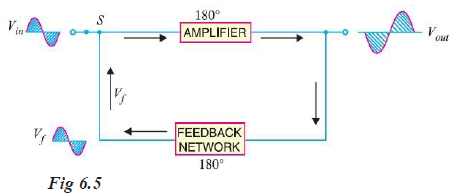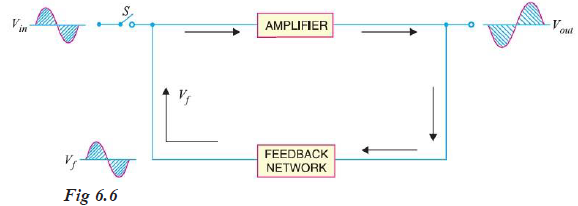- A transistor amplifier with proper positive feedback can act as an oscillator i.e., it can generate oscillations without any external signal source. Fig. 6.5 shows a transistor amplifier with positive feedback.

- Remember that a positive feedback amplifier is one that produces a feedback voltage (V
f) that is in phase with the original input signal. As you can see, this condition is met in the circuit shown in Fig. 6.5. A phase shift of 180° is produced by the amplifier and a further phase shift of 180° is introduced by feedback network. Consequently, the signal is shifted by 360° and fed to the input i.e., feedback voltage is in phase with the input signal.
(i) We note that the circuit shown in Fig. 6.5 is producing oscillations in the output. However, this circuit has an input signal. This is inconsistent with our definition of an oscillator i.e., an oscillator is a circuit that produces oscillations without any external signal source.

(ii) When we open the switch S of Fig. 6.5, we get the circuit shown in Fig. 6.6. This means the input signal (V
in) is removed. However, V
f (which is in phase with the original signal) is still applied to the input signal. The amplifier will respond to this signal in the same way that it did to V
in i.e., V
f will be amplified and sent to the output. The feedback network sends a portion of the output back to the input. Therefore, the amplifier receives another input cycle and another output cycle is produced. This process will continue so long as the amplifier is turned on. Therefore, the amplifier will produce sinusoidal output with no external signal source. - - The following points may be noted carefully:
a) A transistor amplifier with proper positive feedback will work as an oscillator.
b) The circuit needs only a quick trigger signal to start the oscillations. Once the oscillations have started, no external signal source is needed.
c) In order to get continuous undamped output from the circuit, the following condition must be met:
m
vA
v = 1
where A
v = voltage gain of amplifier without feedback
m
v = feedback fraction
This relation is called
Barkhausen criterion.
Wilfykil answered the question on
August 15, 2019 at 09:25